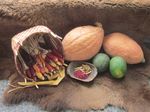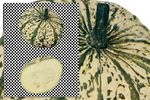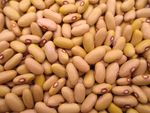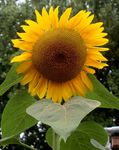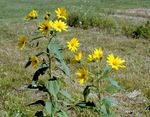2020 Garden Guide Knife River Indian Villages National Historic Site
←
→
Page content transcription
If your browser does not render page correctly, please read the page content below
A Cornerstone to a Culture…. Preserving Cultural Heritage through Seed...
Beyond the Knife River villages over to Like-A-Fish-Hook, gardening was still a cen-
tral focus in the tribal society. But as reservation life began, gardening as a lifeway
waned from the issuance of government rations, difficulty working in upland soils
and other factors. But like many other aspects within the cultural identity of to-
day’s MHA Nation, it was not lost entirely. Recognizing this importance, some con-
tinue to grow and maintain the varieties of their ancestors.
Whether he recognized at the time
or not, Oscar Will of Bismarck pre-
served many of these varieties and
introduced them on a national scale.
In the early 1880s, he travelled to
the Fort Berthold Reservation in
hopes of finding garden varieties
suitable for Northern Plains growing
conditions.
Over the next several years, his cata-
log offered many of these and con-
tinued for more than 70 years.
The rich bottomlands between the Knife and Missouri Rivers provided Hidatsa villagers
with fertile soils to produce extensive garden fields. Generations of experience provided Some of them would be crossed
them with the knowledge of the best planting practices, seed selecting, and harvesting. with others to produce different
strains. For example, the popular
Women of the villages took great pride in this fact and worked hard daily to have a suc-
Great Northern Bean is derived from
cessful growing season. As Buffalo Bird Woman would later state: “We Indian people
white beans grown right here at the
love our gardens, just as a mother loves her children.”
Knife River Indian Villages!
This passion for agriculture was essential for it meant the success of the whole village.
Not only did it provide sustenance for everyone in the villages, but extended out
Today’s Suppliers:
through the entire region has items to trade. Other tribes from every direction would
make their way to the Hidatsas and neighboring Mandans to trade bison meat and There has been a growing resurgence (pun intended) in preserving heirloom varieties of
robes for corn, beans, squash, and sunflowers. fruits and vegetables of all types. These include many native varieties of the Mandan,
Hidatsa, and Arikara (most of them from Will’s Company). Some of these suppliers in-
Just like farmers today, it was commerce and feeding the heartland on a grand scale.
clude: Heritage Harvest Seed, Victory Seed, Seed Saver’s Exchange, Sand Hill Preserva-
tion Center, and Baker Creek Heirloom Seeds.Arikara Watermelon (Citrullus lanatus)
2020 Selected Varieties...
Small plot near Earthlodge
Strong Tobacco (Nicotiana rustica):
This species is common throughout tribes
east of the Mississippi River, although it is
also associated with the Mayans and Aztecs.
It is likely one of two species mentioned by
Meriwether Lewis while visiting Arikara vil-
lages in October of 1804.
It goes by many common names, however,
“strong tobacco” seems to fit well since it
has a nicotine content up to nine times
stronger than today’s common cultivated
tobacco (N. tabacum).
Near front entry of Visitor Center
Indian Tobacco (Nicotiana quadrivalvis):
This species seems to have a wider ac-
From a historical standpoint, this is the most recent addition to the regional Native gar- ceptance of cultivation along the Upper
den. Watermelons are of African origin and were grown in early colonial gardens. Likely Missouri River. Its ancestral roots trace
making there way up from New Orleans, they arrive in St. Louis in the late 18th Centu- back to drier areas of Northern California
ry. Distributed by traders heading up river, it didn’t take long for the sweet treat to and Eastern Oregon.
catch on within the Upper Missouri River region. It is the “smaller species” mentioned by
Amongst an Arikara village in October of 1804, Sergeant John Ordway of the Lewis & Meriwether Lewis who collected samples
Clark Expedition wrote “they Raise considerable of Indian corn, beans pumkins and seed, which later was grown by Thom-
Squasshes water millons a kind of Tobacco &.C. &.C.“ as Jefferson at his Monticello home.
Here within the villages, it made up the
bulk of what was smoked for ceremony and
leisure. In fact, the entire plant is dried for
this purpose with blossoms being a particu-
lar favorite. Sometimes it’s blended with
the leaves of Rose, Kinnikinik, and the inner
bark of Red-twigged Dogwood.
“Arikara Village of Earth-covered lodges, 1600 miles above St. Louis” by George Catlin Hidatsa Name: miríishishaArikara Squash (Cucurbita maxima): Sunflower (Helianthus
annuus)
Not present, grown in 2018 and 2019 Hidatsa name: gagúwi
Hidatsa name: maapáa
This Hubbard-type
variety has large pale
Large plot opposite Earthlodge
orange fruit that can These create the border surrounding
weigh 20+ pounds. the Hidatsa garden. After many genera-
They also store ex- tions of selecting the largest flower
tremely well for the heads for next season’s seed, we have
winter. the sunflower of today.
The texture can be A popular traditional use is to grind
stringy, however, it seed into a coarse meal and roll them
blends well to make an into balls with lard– a high energy trail
excellent soup. food.
Jerusalem Artichoke
Mandan Squash (Cucurbita pepo): (Helianthus tuberosus)
Front of large plot and back of small plot near Earthlodge Hidatsa name: kakca
This variety is quick to mature but does not keep Small plot near Earthlodge
well. Therefore, it is cut lengthwise in thin slices
and strung through a long sturdy stick. After some
time on the drying rack, it is preserved for winter Never cultivated in the gardens, these
use. Its flavor is much less sweet, but can be are harvested as underground tubers
cooked young like a summer squash. growing wild along the riverbottoms.
Also, it is neither from Jerusalem nor an
Its rind can also be yellow with green stripes and
artichoke. It is a sunflower also known
white with orange stripes.
as a Sunchoke.
They have a lot of the starch known as
inulin which can be hard for the human
body to digest. When eaten in large
quantities, they can make you “full of
wind”!Hidatsa Shield Figure Beans
Not present, grown in 2018 and 2019
Pole variety
Hidatsa Red Beans
Not present, grown in 2018 and 2019
Pole variety
Corn (Zea mays)
Hidatsa name: góoxaadi
Large plot opposite Earthlodge
This year’s variety is known as ‘Painted Mountain’- see picture above. It is a variety
that is a composite of over 100 different varieties with over three decades of selec-
tive breeding– many of Mandan origin. Credit going to Dave Christensen of Big Tim- Arikara Yellow Beans
ber, Montana on this project. Large plot near Earthlodge
At least nine varieties were known to exist historically. They are distinguished by their Bush variety
color and hardness. Some are flint (hard) and some are flour (soft). One is even gum-
my! Today they can be found under the labels such as ‘Mandan Bride’ and ‘Mandan
Red Clay’. Why so many Mandan? According to Hidatsa oral history, the Mandan in- Hidatsa Name: awáasha
troduced corn to them...
Long ago, a Hidatsa war party found themselves across the river from a Mandan vil- In general, beans (Phaseolus vulgaris) are traditionally planted between corn that pro-
lage. But they arrived hungry. Some of the Mandan shot arrows with pieces of a cob vides light shade or a support to climb on. These three varieties represent virtually all
of parched corn to the other side and yelled or signed “EAT” ( the word is the same in that is left between the Mandan, Hidatsa and Arikara tribes today. At least with the
both languages). They did and found it good. The excited warriors returned to their Hidatsa, three other varieties were grown– white, black, and spotted.
village an told the others of this new food. Eventually, the Hidatsas moved next to the
All of them are very good picked young as a snap bean or dried as a shelling bean. The
Mandans learned how to grow their own after a chief gave them half an ear of yellow
traditional cooking method is to boil them (green or dry) in a pot with a little bison
corn.
lard.You can also read





